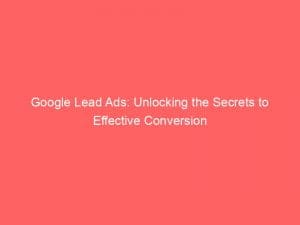In today’s digital age, where consumers are constantly bombarded with information and advertisements, capturing their attention and generating leads has become a daunting task. However, with the advent of Googleleadads, businesses now have a powerful tool at their disposal.
By harnessing the vast reach and targeting capabilities of GoogleAds, companies can effectively connect with their target audience and propel their lead generation efforts to new heights. In this article, we will delve into the essential steps and strategies involved in using Googleleadads, from conducting audience research to optimizing landing pages and tracking key metrics.
Get ready to unlock the potential of Google Ads and discover the secrets to driving maximum ROI for your business.
| Item | Details |
|---|---|
| Topic | Google Lead Ads: Unlocking the Secrets to Effective Conversion |
| Category | Ads |
| Key takeaway | In today's digital age, where consumers are constantly bombarded with information and advertisements, capturing their attention and generating leads has become a daunting task. |
| Last updated | December 27, 2025 |
ads">google leadads
Google lead ads are a form of Google Ads that can be used for lead generation. To effectively create lead generation ads, targeting the right audience is crucial.
Conducting research on the target audience is important and can be done using Google Search Console to gather demographic and interest data. Analyzing search queries, audience demographics, and website performance provides insights that can be used to tailor ad copy to the target audience.
Thorough keyword research should be done using tools like Google Keyword Planner to optimize ad targeting. Crafting compelling ad copy with clear calls to action and optimizing landing pages with engaging design and conversion elements help improve ad performance.
Utilizing ad extensions can provide additional information and improve ad visibility. Key metrics such as click-through rate (CTR), cost per click (CPC), conversion rate, and cost per lead (CPL) should be tracked to measure ad effectiveness.
Conversion tracking should be set up to measure the impact of the ads. Monitoring competitors’ advertising strategies can provide insights and help differentiate your ads.
Location targeting can be used for local relevance, and remarketing can be implemented to reconnect with website visitors. Continuously testing, optimizing, and analyzing performance is essential for maximizing return on investment (ROI).
Key Points:
- Google lead ads are used for lead generation in Google Ads.
- Researching the target audience using Google Search Console is important for effective lead generation ads.
- Keyword research using tools like Google Keyword Planner helps optimize ad targeting.
- Crafting compelling ad copy and optimizing landing pages improve ad performance.
- Utilizing ad extensions improves ad visibility and provides additional information.
- Tracking metrics like CTR, CPC, conversion rate, and CPL measures ad effectiveness.
- Setting up conversion tracking and monitoring competitors’ strategies is vital.
- Location targeting and remarketing can be used for local relevance and reconnecting with visitors.
- Continuously testing, optimizing, and analyzing performance is essential for maximizing ROI.
Sources
https://www.wordstream.com/blog/ws/2023/07/20/google-ads-for-lead-generation
https://ads.google.com/local-services-ads/
https://leadsbridge.com/blog/google-lead-form-ads/
https://cybernews.com/security/google-search-results-lead-malware/
Check this out:
💡 Pro Tips:
1. Leverage Google Lead Form Extensions: Google Lead Ads offer lead generation forms directly within the ad, making it easier for users to submit their information. Take advantage of this feature to collect leads without requiring users to leave the ad.
2. Implement A/B Testing: Experiment with different ad variations to determine which ones perform the best. Test different headlines, ad copy, and images to optimize your lead generation ads.
3. Utilize Customer Match: Upload your customer email lists to Google Ads and use Customer Match to target your existing customers or similar audiences with personalized ads. This can help improve your ad relevance and conversion rates.
4. Use Negative Keywords: Exclude keywords that are not relevant to your target audience to improve the quality of your leads. Negative keyword targeting ensures that your ads are shown to the most relevant audience.
5. Leverage Lookalike Audiences: Use Google Ads’ Lookalike Audiences feature to target audiences that resemble your existing customer base. This can help expand your reach and attract new leads with similar characteristics and interests.
Target Audience Research
In the world of Google Lead Ads, understanding your target audience is crucial for effective lead generation. By conducting thorough research on your audience, you can tailor your ads to resonate with their interests, needs, and preferences.
To begin, start by identifying who your target audience is. Consider factors such as demographics, interests, behaviors, and pain points.
This will help you create ads that are highly targeted and relevant to your audience’s needs.
Once you have a clear understanding of your target audience, you can delve deeper into their preferences and interests. Zero in on their online behavior and the websites they frequently visit.
This will give you insight into the types of content they engage with and the topics that are of interest to them.
Gathering Demographic And Interest Data
To gather demographic and interest data about your target audience, you can leverage Google Search Console. This powerful tool provides valuable insights into your website’s performance, including data on your visitors’ demographics and interests.
By analyzing this data, you can gain a better understanding of who your audience is and what resonates with them. Look for patterns and trends in the data to identify key segments within your target audience.
Additionally, Google Search Console can provide valuable information about the search queries that are driving traffic to your website. By understanding the keywords used by your target audience, you can optimize your ad copy to align with their search intent and capture their attention.
Analyzing Search Queries And Audience Demographics
Analyzing search queries is an important component of lead generation ads. By understanding the words and phrases your audience uses, you can create ads that speak directly to their needs and motivations.
Take the time to analyze the search queries your audience is using to find your website. Look for patterns and common themes in their search behavior.
This will help you uncover insights into their desires, pain points, and expectations.
In addition to search queries, analyzing audience demographics is equally important. By understanding the demographic makeup of your audience, you can tailor your ad copy and design to better resonate with them.
For example, if you discover that your audience consists mostly of young professionals, you can incorporate language and imagery that appeals to this group.
Tailoring Ad Copy To Target Audience
Once you have gathered and analyzed the necessary data, it’s time to put it to use and tailor your ad copy to your target audience. Use the insights from Google Search Console to inform and guide your ad creation process.
Write ad copy that directly addresses the pain points and desires of your target audience. Use language that resonates with them and speaks to their specific needs.
Highlight the benefits they can expect from engaging with your offer.
In addition to the ad copy, pay attention to the design and visual elements of your ads. Use imagery that appeals to your target audience and reflects their interests and aspirations.
By aligning your ad copy and design with your audience’s preferences, you can significantly increase the chances of generating quality leads.
Fresh tips added for marketers this month.
Self-Serve DSP Platform • Performance Marketing Tips • Buy Traffic • Advertising Platform for Marketers











